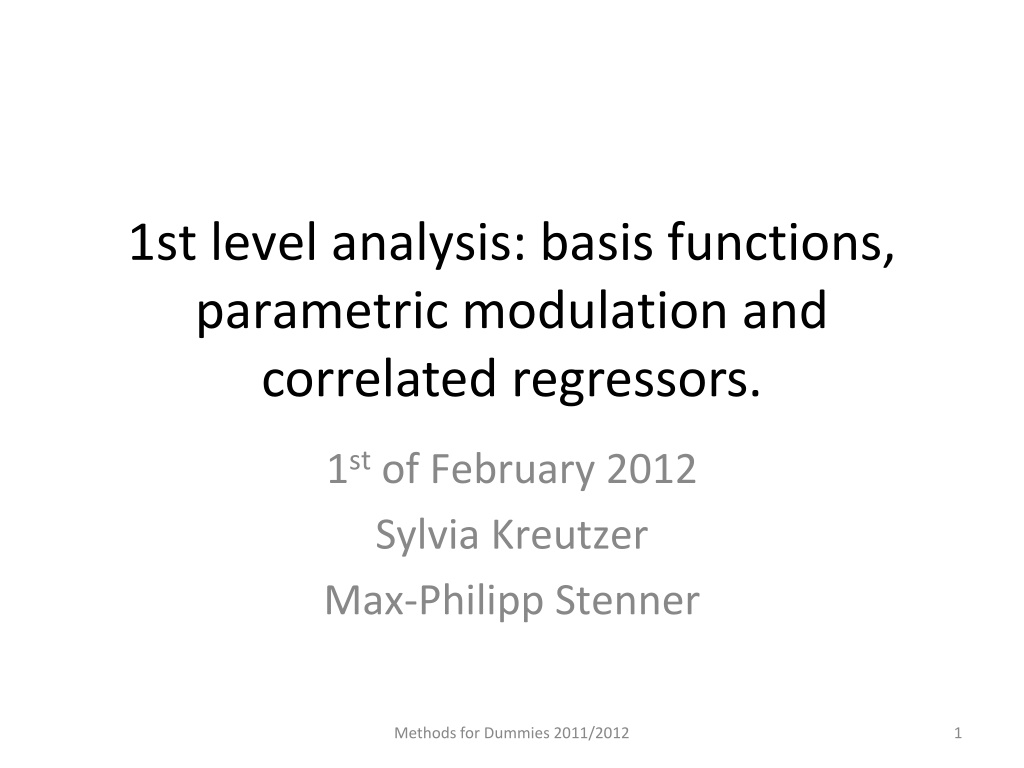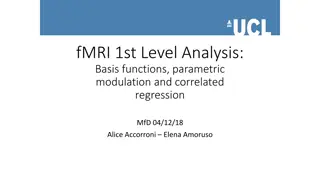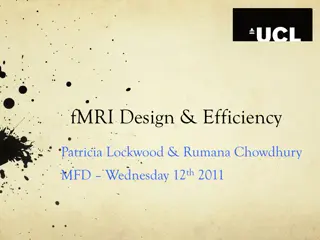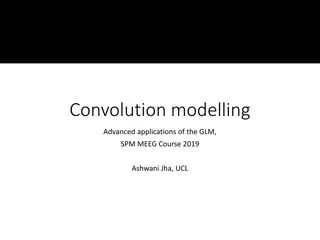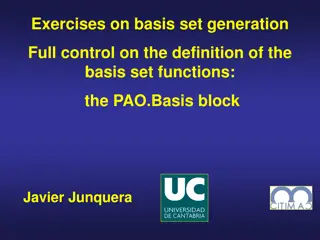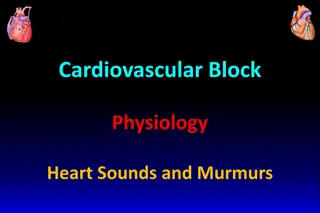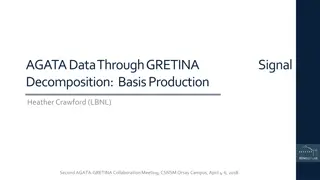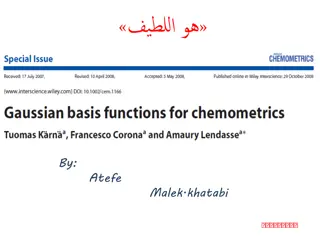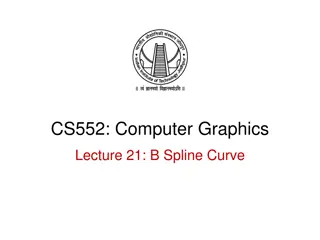Understanding Basis Functions and Hemodynamic Response Functions in fMRI Analysis
This content discusses the use of basis functions, parametric modulation, and correlated regressors in the first-level analysis of fMRI data processing. It delves into the concept of temporal basis functions for modeling complex functions of interest, such as the canonical hemodynamic response function (HDRF). Additionally, it explores the hemodynamic response function (HRF) and the use of gamma functions for representing the hemodynamic response in fMRI studies.
- fMRI analysis
- basis functions
- hemodynamic response function
- fMRI data processing
- temporal basis functions
Download Presentation

Please find below an Image/Link to download the presentation.
The content on the website is provided AS IS for your information and personal use only. It may not be sold, licensed, or shared on other websites without obtaining consent from the author. Download presentation by click this link. If you encounter any issues during the download, it is possible that the publisher has removed the file from their server.
E N D
Presentation Transcript
1st level analysis: basis functions, parametric modulation and correlated regressors. 1stof February 2012 Sylvia Kreutzer Max-Philipp Stenner Methods for Dummies 2011/2012 1
First Level Analysis Data analysis with SPM Pre-processing of the data (Alignment, smoothing etc.) First Level Analysis Basis Functions (Sylvia) Experimental design and correlated regressors (Max) Random Field theory (next talk) Second Level Analysis Methods for Dummies 2011/2012 2
Image time-series Design matrix Statistical Parametric Map Spatial filter Realignment General Linear Model Smoothing Statistical Inference RFT Normalisation p <0.05 Anatomical reference Parameter estimates
Basis Functions Temporal basis functions are used to model a more complex function Function of interest in fMRI Percent signal change over time How to approximate the signal? We have to find the combination of functions that give the best representation of the measured BOLD response Default in SPM: Canonical hemodynamic response function (HDRF) Methods for Dummies 2011/2012 4
Basis Functions Many different possible functions can be used f(t) h1(t) h2(t) h3(t) Fourier analysis The complex wave at the top can be decomposed into the sum of the three simpler waves shown below. f(t)=h1(t)+h2(t)+h3(t) Finite Impulse Response (FIR) Methods for Dummies 2011/2012 5
Hemodynamic Response Function (HRF) Since we know the shape of the hemodynamic response, we should use this knowledge and find a similar function to model the percentage signal change over time. This is our best prediction of the signal. Peak Brief Stimulus Undershoot Initial Undershoot Hemodynamic response function Methods for Dummies 2011/2012 6
Hemodynamic Response Function (HRF) Two gamma functions added together form a good representation of the haemodynamic response, although they lack the initial undershoot! Gamma functions Two Gamma functions added Methods for Dummies 2011/2012 7
LIMITS OF HRF General shape of the BOLD impulse response similar across early sensory regions, such as V1 and S1. Variability across higher cortical regions. Considerable variability across people. These types of variability can be accommodated by expanding the HRF...
Informed Basis Set Canonical HRF Temporal derivative Dispersion derivative Canonical HRF (2 gamma functions) plus two expansions in: Time: The temporal derivative can model (small) differences in the latency of the peak response Width: The dispersion derivative can model (small) differences in the duration of the peak response. Methods for Dummies 2011/2012 10
Design Matrix Left Right Mean 3 regressors used to model each condition The three basis functions are: 1. Canonical HRF 2. Derivatives with respect to time 3. Derivatives with respect to dispersion Methods for Dummies 2011/2012 11
GENERAL (CONVOLUTED) LINEAR MODEL Ex: Auditory words every 20s Gamma functions i( ) of peristimulus time SPM{F} Sampled every TR = 1.7s Design matrix, X [x(t) 1( ) | x(t) 2( ) |...] 0 time {secs} 30 REVIEW DESIGN
Comparison of the fitted response Haemodynamic response in a single voxel. Left: Estimation using the simple model Right: More flexible model with basis functions Methods for Dummies 2011/2012 13
Summary SPM uses basis functions to model the hemodynamic response using a single basis function or a set of functions. The most common choice is the `Canonical HRF' (Default in SPM) By adding the time and dispersion derivatives one can account for variability in the signal change over voxels Methods for Dummies 2011/2012 14
Sources www.mrc-cbu.cam.ac.uk/Imaging/Common/rikSPM-GLM.ppt http://www.fil.ion.ucl.ac.uk/spm/doc/manual.pdf And thanks to Guillaume! Methods for Dummies 2011/2012 15
Part II: Correlated regressors parametric/non-parametric design Methods for Dummies 2011/2012 16
Multicollinearity yi= 0+ 1xi1+ 2xi2+ + NxiN+ e Coefficients reflect an estimated change in y with every unit change in xi while controlling for all other regressors Methods for Dummies 2011/2012 17
Multicollinearity yi= 0+ 1xi1+ 2xi2+ + NxiN+ e { xi1= 0+ xi2+ v low variance of v high variance of v Xi1 Xi1 (e.g. age) x x x x x x x x x x x x x x x x x x x x x x Xi2 Xi2 (e.g. chronic disease duration) Methods for Dummies 2011/2012 18
Multicollinearity and estimability y OLS minimizes e by e Xe = 0 with x2 y = e = Y (X estim)-1 X which gives x1 estim= (XTX)-1XTY (SPM course Oct. 2010, Guillaume Flandin) cf high multicollinearity (i.e. variance of v small) perfect multicollinearity (i.e. variance of v = 0) covariance matrix inaccuracy of individual estim, high standard error det(X) = 0 (XTX) not invertible estimnot unique Methods for Dummies 2011/2012 19
Multicollinearity (t- and [unidimensional] F-) testing of a single regressor (e.g. R1) = testing for the component that is not explained by (is orthogonal to) the other/the reduced model (e.g. R2) multicollinearity is contrast specific R1 Xi estim R1 conflating means of (multidimensional) F-contrasts permits assessing common contribution to variance correlated regressors by R2 (Xi estim= projection of Yionto X space) Methods for Dummies 2011/2012 20
Multicollinearity (relatively) little spread after projection onto regressor 2 x hrf x-axis, y-axis or f(x) = x reflecting reduced efficiency for detecting dependencies of the observed data on the respective (combination of) regressors regressor 1 x hrf (MRC CBU Cambridge, http://imaging.mrc-cbu.cam.ac.uk/imaging/DesignEfficiency) Methods for Dummies 2011/2012 21
Orthogonality matrix reflects the cosine of the angles between respective pairs of columns (SPM course Oct. 2010, Guillaume Flandin) Methods for Dummies 2011/2012 22
Orthogonalizing leaves the parameter estimate of R1 unchanged but alters the estimate of the R2parameter X estim R1orth R1 assumes between the orthogonalized predictor and the dependent attributing the common variance to this one predictor only unambiguous causality variable by R2 R2new hence rarely justified Methods for Dummies 2011/2012 23
Dealing with multicollinearity Avoid. (avoid dummy variables; when sequential scheme of predictors (stimulus response) is inevitable: inject jittered delay (see B) or use a probabilistic R1-R2sequence (see C)) Obtain more data to decrease standard error of parameter estimates Use F-contrasts to assess common contribution to data variance (MRC CBU Cambridge, Orthogonalizing might lead to self- fulfilling prophecies http://imaging.mrc-cbu.cam.ac.uk/imaging/DesignEfficiency) Methods for Dummies 2011/2012 24
Parametric vs. factorial design Widely-used example (Statistical Parametric Mapping, Friston et al. 2007) factorial Four button press forces 5 5 parametric 10 10 15 15 20 20 25 25 30 30 0.5 1 1.5 2 2.5 3 3.5 0.5 1 1.5 2 2.5 3 3.5 4 4.5 Methods for Dummies 2011/2012 25
Parametric vs. factorial design Which when? Limited prior knowledge, flexibility in contrasting beneficial ( screening ): factorial 5 5 parametric 10 10 Large levels/continuous range: number of 15 15 20 20 25 25 30 30 0.5 1 1.5 2 2.5 3 3.5 0.5 1 1.5 2 2.5 3 3.5 4 4.5 Methods for Dummies 2011/2012 26
Happy mapping! Methods for Dummies 2011/2012 27
